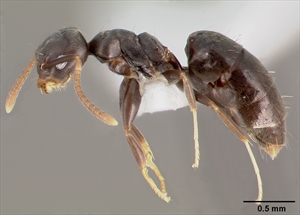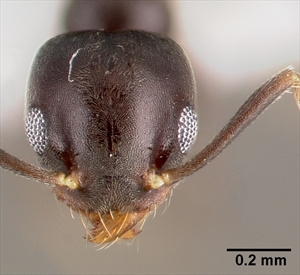White-footed ant. It is also known as the difficult white-footed ant, or the difficult techno ant.
Pacific Pests, Pathogens, Weeds & Pesticides - Online edition
Pacific Pests, Pathogens, Weeds & Pesticides
White-footed ant - Technomyrmex difficilis (480)
Technomyrmex difficilis. This ant has been misidentified previously, confused with Technomyrmex albipes (see Fact Sheet no. 360). There are other closely-related species, Technomyrmex pallipes, and Technomyrmex mayri st. nitiduans.
Asia, Africa (Madagascar, Reunion, Seychelles, South Africa), North and Central America, the Caribbean, Oceania. It is recorded from Australia, Guam, Federated States of Micronesia (Chuuk), Papua New Guinea.
A major household, garden and greenhouse pest. A nuisance as it makes nests in homes and other buildings (but does not cause structural damage), and damaging because it encourages scale insect outbreaks by protecting them from their natural enemies. Its appearance and life-cycle is similar to that of Technomyrmex albipes.
The ant is 2-4 mm long with legs that have white lower parts (Photos 1&2). There are winged and wingless males, and three types of females: queens, intercastes and workers. Winged males and winged females mate in a nuptial flight, the females lose their wings, find a site to start the colony and begin egg-laying. Later, the intercastes - wingless females that can store sperm - mate with wingless males in the colony, and take over the reproductive tasks. Nearly half the colony is made up of these reproductive intercastes.
Foraging is done by unfertilised females (workers); these also build and care for the nest, and care for the brood (larvae and pupae). The colony may contain several nest sites, with millions of ants. This is an ant that is difficult to control. Nests are found in trees and bushes, tree holes, under leaves on trees, under debris and leaf litter, in gutters, wall voids and attics.
Apart from collecting honeydew (Photo 3), the ants feed on living and dead insects, food scraps, and their own eggs. They are often found foraging in kitchens and bathrooms. They do not bite or sting.
Spread of the colony occurs by 'budding': intercastes leave with workers, males and brood, to establish a new nest site. Rapid spread in this way is a reason for the successful establishment of this ant in new environments.
Apart from its nuisance in buildings, the impact is on agriculture by protecting scale insects. In Sri Lanka, it is reported to spread pineapple wilt by protecting the mealybug, Dysmicoccus brevipes (see Fact Sheet no. 380), and in South Africa by causing outbreaks of the red scale, Aonidiella aurantii, and the long-tailed mealybug, Pseudococcus longispinus, in citrus. By contrast, a beneficial act is reported: it reduces damage of a coconut caterpillar, Opisina arenosaella, in Sri Lanka by predating eggs of the moth.
Look for hairs on the top of the head behind the back of the eye. However, sometimes the hairs are worn away and the ants have been confused with Technomyrmex albipes, and with other related species. Another way to distinguish albipes from difficilis is to look at the face front on and at the position of the eyes: are they inside the line of the edge of the head (albipes), or do the eyes protrude slightly over the edge of the line of the head (difficilis) (Photo 4)? Consult the following.
The PIAkey provides charts with Technomyrmex albipes, difficilis and vitiensis side-by-side for comparison of important taxonomic features used to distinguish the species: (http://idtools.org/id/ants/pia/Fact_Sheets/Technomyrmex_difficilis.html).
The app: Antkey Mobile: an identification key for introduced ants. USDA. LUCID, is useful for preliminary examination, as is the online version: (http://idtools.org/id/ants/pia/PIAkey_v2.html).
The Pacific Invasive Ants Taxonomy Workshop manual has a key to the Pacific species and is well illustrated: (http://www.issg.org/cii/Electronic%20references/pii/project_docs/papp/pacific_ants_taxonomy_workshop_2009.pdf).
However, it is best to be sure, so always send specimens to experts for critical examination and confirmation of identification.
QUARANTINE
Countries still free of Technomyrmex difficilis, but vulnerable to this white-footed ant, need to: (i) define the risk; (ii) have preventive measures in place against an introduction; (iii) have quarantine protocols enacted in case of a breach; and (iv) be able to carry out a rapid response against this ant in case eradication is a possibility. In addition, it is necessary to have biosecurity regulations to prevent movement of the ant within the country, especially in Pacific island countries where most are island groups or archipelagos. Finally, monitoring is required on the islands still free from infestation.
A Pacific Ant Prevention Plan has been written on behalf of the IUCN/SSC Invasive Species Specialist Group and presented to the Pacific Plant Protection Organisation and Regional Technical Meeting for Plant Protection (2004). Technomyrmex difficilis is NOT one of the 11 species covered. but the closely related Technomyrmex albipes can be used as a guide. The Plan focuses on ways to prevent the introduction, establishment and spread of this ant: (http://issg.org/database/species/reference_files/PAPP.pdf).
Guidelines to assist Pacific island countries and territories in planning effective management of invasive species have also been prepared by the Pacific Community and the Secretariat of the Pacific Regional Environment Programme: (http://www.piat.org.nz/uploads/PIAT_content/pdfs/SPREP%20guidelines%20for%20invasive%20species%20management%20in%20the%20Pacific.pdf).
The IUCN/SSC Invasive Species Specialist Group website should be consulted for details on all aspects of eradication and management of invasive ants: (http://www.issg.org/).
CULTURAL CONTROL
Trim trees and shrubs that surround nests to prevent bridges to other vegetation, or touch exterior walls. Hot water at 47°C (and above) kills ants. Hot water up to 49°C will not damage plants. A more extreme method is to use fire to destroy the nests and to create conditions that favour native ant species.
CHEMICAL CONTROL
This method of control is not practical in many situations as nests are in the canopy of trees where spraying is not only difficult but also uneconomic. There is also a problem in that chemicals are not passed between individuals (i.e., food is not taken back to the nest and regurgitated), and that baits containing poisons have to be taken by a large percentage of the colony to be effective. However, if enough workers are killed, the young may starve to death.
In general, three types of chemicals are used against ants: (i) stomach poisons, e.g., Maxforce® (fipronil), Amdro® (hydramethylnon), and borax; (ii) insect growth regulators, e.g., Engage® (methoprene), and Distance® (pyriproxyfen); and (iii) poisons that work on the nervous system, that is, neurotoxins, e.g., bifenthrin, fipronil, and imidacloprid. Stomach poisons kill all queens, intercastes and workers; insect growth regulators stop the queens from laying eggs, whereas neurotoxins disrupt insects' central nervous system. It is likely that future products will combine toxins that cause rapid death and insect growth regulators, e.g., Extinguish Plus® (hydramethylnon and methoprene).
A note of caution: Although it is possible to combine a lure (such as peanut butter, fish, sugar, etc.) with a pesticide as an ant bait, it is not recommended because of the danger in leaving concentrated pesticides unattended in the environment, including dwellings.
Treatment options (and case studies) are provided in the Pacific Invasive Ant Toolkit under http://piat.org.nz/.
____________________
When using a pesticide, always wear protective clothing and follow the instructions on the product label, such as dosage, timing of application, and pre-harvest interval. Recommendations will vary with the crop and system of cultivation. Expert advice on the most appropriate pesticides to use should always be sought from local agricultural authorities.
AUTHOR Grahame Jackson
Information from Technomyrmex difficilis Forel, 1892. Atlas of Living Australia. (https://bie.ala.org.au/species/urn:lsid:biodiversity.org.au:afd.taxon:2b32ef9e-a083-42b1-8a0a-93a69330eb7a); and AntWeb, v8.47 (2020) California Academy of Science, online at: (https://www.antweb.org/description.do?genus=Technomyrmex&species=difficilis); and from Warner J, Scheffrahn RH (2010) Technomyrmex difficilis (=albipes) Florel. Featured Creatures. UF/IFAS. University of Florida. (http://entnemdept.ufl.edu/creatures/urban/ants/white-footed_ant.htm). Photos 1-3 April Nobile. AntiWiki (https://www.antwiki.org/wiki/Technomyrmex_difficilis): Photo 1 Head view of ant Technomyrmex difficilis. Photo 2 Profile view of ant Technomyrmex difficilis. Photo 3 Dorsal view of ant Technomyrmex difficilis. Photo 4 Mark Ayers HumanObservation of Technomyrmex difficilis recorded on 2020-04-13. Atlas of Living Australia. (https://biocache.ala.org.au/occurrences/2e38e2c0-4682-4546-89a2-a0f39a2e31ac).
Produced with support from the Australian Centre for International Agricultural Research under project HORT/2016/185: Responding to emerging pest and disease threats to horticulture in the Pacific islands, implemented by the University of Queensland and the Secretariat of the Pacific Community.







